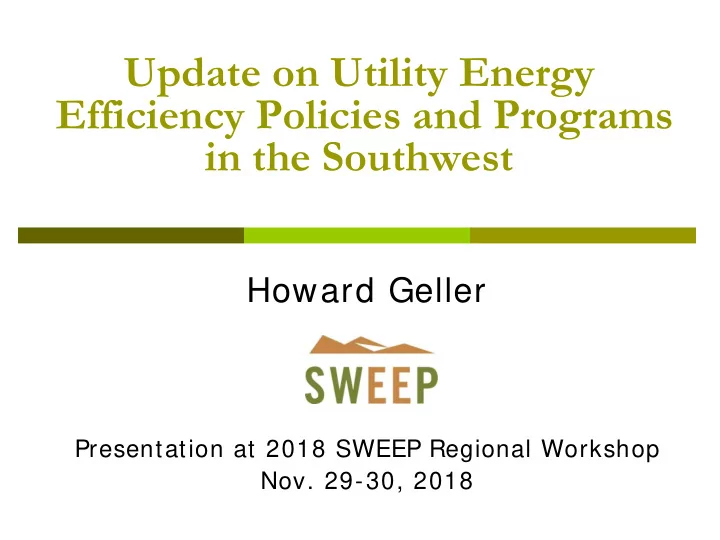

Update on Utility Energy Efficiency Policies and Programs in the Southwest Howard Geller Presentation at 2018 SWEEP Regional Workshop Nov. 29-30, 2018
Electric Utility DSM Program Spending Trends 4 5 0 4 0 0 3 5 0 Million $ per year 3 0 0 2 5 0 2 0 0 1 5 0 1 0 0 5 0 0 2 0 0 4 2 0 0 6 2 0 0 8 2 0 1 0 2 0 1 2 2 0 1 4 2 0 1 6 2 0 1 7 2 0 1 8 AZ CO NV NM UT W Y
Energy Savings Trends for Major Electric Utilities in the Southwest Savings from Programs Implemented each Year (GWh/yr) 2500 2000 1500 1000 500 0 2007 2008 2009 2010 2011 2012 2013 2014 2015 2016 2017 APS TEP SRP Xcel-CO RMP-UT NV Energy PNM
First Year Energy SavingsTrends Annual Energy Savings as a % of Retail Sales, by program year 2.5% 2.0% 1.5% 1.0% 0.5% 0.0% 2007 2008 2009 2010 2011 2012 2013 2014 2015 2016 2017 APS TEP SRP Xcel-CO RMP-UT NV Energy PNM
Gas Utility DSM Program Spending and Saving Trends DSM Program Funding DSM Program Savings (Million $) (thousand Dtherms) 2018 2018 Utility 2015 2016 2017 2015 2016 2017 (est.) (est.) NMGC 4.3 4.4 5.8 5.8 79 76 140 140 Questar 24.2 23.3 22.4 24.5 762 901 892 1,145 SW Gas 3.0 4.6 3.4 5.5 360 350 370 500 (AZ) Xcel 12.9 13.7 14.9 12.8 598 615 627 573 Energy Region 44 46 46.5 48.5 1,799 1,942 2,029 2,358
Key Policy Issues - Arizona Utilities met EERS (IOUs) or exceeded internal goals (SRP) through 2017 SRP increased energy savings in FY2018 APS and TEP submitted 2018 DSM plans; still not approved but could be taken up by ACC in Dec. or Jan. APS plan includes significant reduction in EE funding with more $ for DR programs and reallocation of EE program $ to EV charging infrastructure and EVs (e.g., school buses) APS proposed ending res. & comm. lighting offerings, high efficiency AC programs, and C&I refrigeration measures TEP proposed level funding and restoration of DSM surcharge, but a modest reduction in energy savings APS and TEP submitted IRPs that reduced role for EE resources post 2020 — IRPs were not accepted by ACC
Key Policy Issues – Colorado Xcel Energy DSM Strategic Issues docket completed PUC increased energy savings goal to 500 GWh/ yr during 2019-23, up from 400 GWh/ yr Budget cap for EE programs increased to $93.6M New avoided energy cost methodology, higher non- energy benefits adders and geo-targeting pilot program Xcel submitted a 2019-20 DSM plan intended to meet new goals; proceeding underway Need to fill savings gap caused by declining NTG ratios for residential and business lighting programs Black Hills Energy 2019-21 DSM plan nearly approved; settlement agreement increased funding levels and savings goals
Key Policy Issues – Nevada NV Energy 2019-21 DSM plan approved Increases DSM funding by ~ 30% to about $66 million/ yr Increases energy savings target to about 345 GWh/ yr, equal to ~ 1.15% of sales Includes new residential lighting, pool pumps and low- income programs PUCN rulemaking nearing completion to establish energy savings goals and other new policies called for by 2017 legislation Goal likely to be 1.1% savings per year or greater but start date still uncertain 2018 Energy Choice ballot initiative failed!
Key Policy Issues – New Mexico 2018-19 DSM program plans and budgets are mostly a continuation of status quo El Paso Electric 2019-21 DSM plan waiting for PRC approval; SPS and NMGC will submit new three-year plans in 2019 Utilities will meet 2020 EERS ahead of schedule; uncertainty about goals/ programs after 2020 New legislation in 2019 could extend EERS beyond 2020 and allow for increased DSM funding PNM proposed LRAM in a docket regarding disincentive removal; EE advocates supporting decoupling or a modified form of LRAM
Key Policy Issues – Utah/WY Rocky Mountain Power reduced DSM program spending and energy savings in 2018, due to targets specified in PacifiCorp’s 2017 IRP RMP ended incentives for LED lamps for C&I customers as of July 1. Incentives continued for LED lamps and fixtures with controls LED lamp sales plummeted as a result RMP’s 2019 DSM budget up but energy savings target not increased relative to that in 2018 2018-20 DSM plan approved for RMP (WY) – includes higher spending and savings targets PacifiCorp working on its 2019 IRP which will establish new energy savings targets in UT and WY
Impacts from a Decade of Electric Utility EE Programs in the Southwest Over 20 billion kWh/ yr of electric savings as of 2017 Nine baseload power plants avoided (300 MW each) ~ $7.5 billion in net economic benefits for households and businesses 80 million tons of avoided CO 2 emissions during 2008-17
Summary DSM budgets and energy savings moving up in CO and NV; savings also increasing at SRP in AZ APS attempting to roll back effective EE programs; remains to be seen if this will get approved RMP lowered energy savings targets in UT but increased them in WY Budgets & energy savings relatively steady in NM Major issues and uncertainties looking forward Potential impact of EISA 2020 light bulb standard Duration of the C&I LED lighting transition Controls & data revolutions/ integration of EE and DR Declining avoided costs/ growing renewables penetration
SWEEP: Dedicated to More Efficient Energy Use in the Southwest Resources available online at: www.swenergy.org Howard Geller, Executive Director 303-447-0078x1 hgeller@swenergy.org
Recommend
More recommend